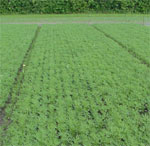 |
Subproject 4
Catch crops as a tool for increasing P bioavailability in soils of low P status
Participants
Associate Professor Lars Stoumann Jensen (Project leader), PhD student Anders Pedersen, Associate Professor Jakob Magid, Professor Niels Erik Nielsen, Plant Nutrition and Soil Fertility Laboratory, The Royal Veterinary and Agricultural University, Copenhagen, Denmark
Emails: lsj@kvl.dk , ander@kvl.dk , jma@kvl.dk , nen@kvl.dk
Project: Projekt-link
Background
We have reasonably solid knowledge about the effect of catch crops and green manures on nitrogen (N) availability for the succeeding crop, but we know very little about their effect on phosphorous (P) availability and supply for the next crop in the rotation. Production of organic market crops without P application will sooner or later become limited by soil P availability, depending on the soil P status at the time of conversion to organic farming. This will in particular affect crop establishment and be most pronounced in row cultivation of vegetable crops, which often have a somewhat limited root system. In contrast to N, catch crops and green manures are unlikely to affect over winter leaching of the relatively immobile P, but some catch crops and green manures may accumulate significant amounts of P, which may be released upon incorporation and possibly become available to the following main crop, depending on incorporation time and crop rotation. We also know that plant species, and even varieties within the same species, differ greatly in their ability to mobilise and take up P from soils with low P status.
Purpose
The project objective is to test selected catch crop species for their P uptake capacity on a low P status soil, to quantify the influence of these catch crops on subsequent main crop yield and P uptake and to quantify possible interactions between catch crop species, the crop rotation (with or without grass-clover ley) and additional P supply for the main crop.
Activities
Studies will be carried out in a field experiment over two years (2001-2002, 2002-2003) in the Nutrient Depletion Trial at KVL’s Research Farms in Taastrup, a site that hasn’t received P or K containing fertilisers or manures for more than 30 years. In 1996 a new field trial was laid out in part of the field, with two crop rotations and seven nutrient application treatments. In selected treatments (0P and 0K, 0P and 50K, 10P and 50K) 5 selected catch crops (Ryegrass, Lupin, Chicory, Rumex and Kidney Vetch) are undersown in Spring barley.
Sampling and analyses will include biomass production and N, P and K uptake of the catch crops in late autumn and main crop two or three times in the initial growth stages and once at harvest. In addition, the catch crop effect on autumn and spring mineral N content is measured.
Results
Preliminary results from the first experimental year indicate that the non N-fixing catch crop species do not attain a very high biomass production on this relatively infertile site, with a maximum uptake of 20-30 kg N, 2-5 kg P and 20-40 kg K per ha, most for Chicory and Ryegrass. The N-fixing green manures are at the same level with respect to P and K uptake, but naturally a larger N uptake, ca. 30-60 kg per ha, most for Kidney Vetch. However, there seems to be no significant effect on either yield, N, P or K uptake in the succeeding Spring barley crop, although marked P deficiency symptoms were observed in the field in early growth stages. The experiments are repeated in 2002/2003 and results from this second round will be available in 2004.
Figure 1 (3 pictures) Nutrient depletion trial; Chichory and Kidney vetch in November
  
Click on the images to get larger view
Publications under preparation
Catch crops on nutrient depleted sandy loam soils – do they increase P and K availability for subsequent crops? Popular paper, April 2004.
Can leguminous and non-leguminous cover crops increase P and K availability on low fertility soils? Scientific manuscript for peer-reviewed journal, August 2004.
|